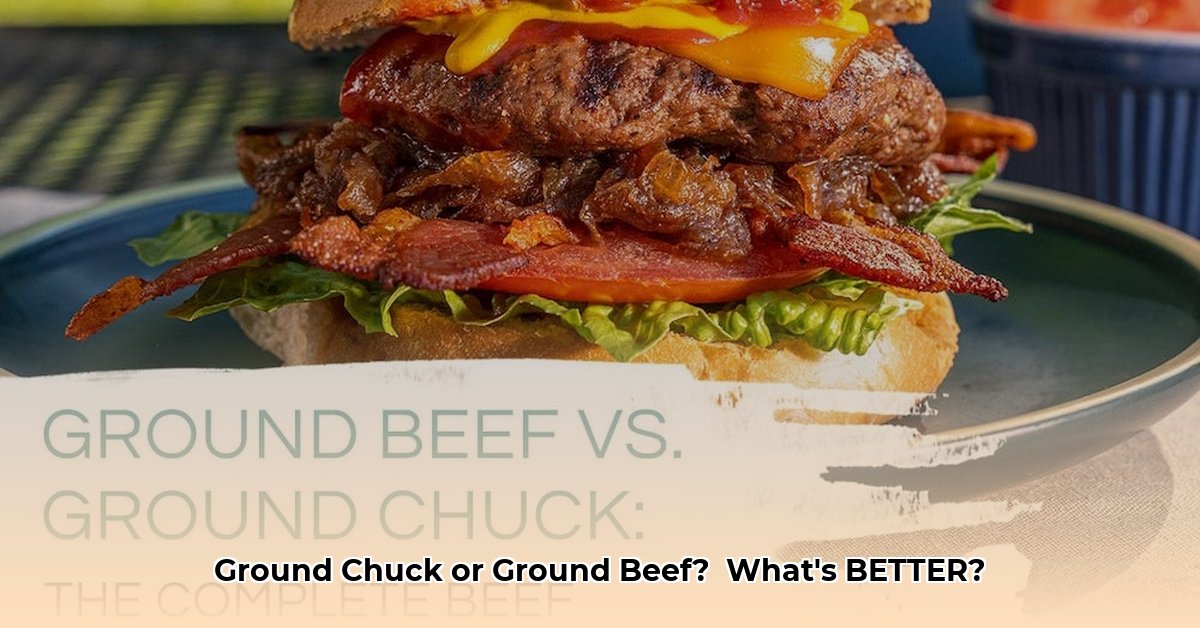Ever stood bewildered in the meat aisle, staring at the seemingly endless ground beef options? You’re not alone! Ground chuck, ground beef…what’s the difference? This guide clears up the confusion, helping you choose the perfect ground meat for any culinary creation.
Decoding the Differences: A Quick Overview
| Feature | Ground Chuck | Ground Beef |
|---|---|---|
| Fat Content | Higher (typically 15-20%, often 80/20) | Varies widely (5-30%, check the label!) |
| Flavor | Rich, intensely beefy | Milder, more versatile |
| Texture | Tender, juicy, may shrink when cooked | Firmer, holds shape well, can crumble easily |
| Best Uses | Burgers, meatloaf, meatballs | Tacos, chili, meat sauce, casseroles |
| Price | Generally more expensive | Usually less expensive |
Fat: The Flavor & Texture Foundation
Fat is key to ground meat’s deliciousness. Ground chuck, from the cow’s shoulder, boasts higher fat, usually an 80/20 ratio (80% lean meat to 20% fat). This translates to a rich, melt-in-your-mouth experience. Standard ground beef, a blend of various cuts, offers a wider range of fat percentages. Opt for lean (90/10 or higher) for health-conscious choices, or higher fat blends (70/30 or 80/20) for maximum flavor, keeping in mind that fat content may vary. Current research continues to explore the multifaceted relationship between fat content, perceived flavor, and overall enjoyment in ground meat.
Flavor: Bold vs. Adaptable
Ground chuck delivers that classic, intense beefy flavor. Standard ground beef, particularly leaner versions, provides a more neutral base for other ingredients to shine. This adaptability makes it great for tacos, chili, or meat sauce.
Texture: Form vs. Crumble
Ground chuck’s higher fat content helps it hold its shape beautifully—ideal for burgers or meatloaf. Leaner ground beef, while firmer, crumbles easily, making it perfect for dishes where the meat blends in, such as chili or Bolognese.
Beyond Chuck & Regular: Expanding Your Meat Horizons
Don’t stop at chuck and regular! Ground sirloin offers a leaner, yet flavorful option. Venture into grass-fed, organic, or custom grinds for unique flavor profiles. Ongoing research explores how feeding practices impact ground meat’s taste and composition.
Mastering the Grind: Cooking Methods & Tips
Higher fat content in ground chuck means more shrinkage and potential flare-ups when grilling. Adjust cooking times and techniques accordingly. For leaner grinds, add moisture like broth or olive oil to prevent dryness.
Food Safety First: Storage & Handling
Regardless of your choice, handle ground meat safely. Refrigerate promptly, use within two days, or freeze for longer storage. Always cook to an internal temperature of 160°F (71°C).
What Exactly is Ground Chuck?
Ground chuck comes from the chuck roast, located in the cow’s shoulder. This well-exercised muscle develops intramuscular fat (marbling), which imparts rich flavor and juiciness. The typical 80/20 ratio makes it ideal for burgers, meatballs, and meatloaf.
What Exactly is Ground Beef?
Ground beef is a mix of trimmings from various cuts, leading to variable fat content and milder flavor. Its adaptability shines in dishes like chili, tacos, and pasta sauce.
Key Differences Summarized
| Feature | Ground Chuck | Ground Beef |
|---|---|---|
| Source | Chuck roast only | Blend of various cuts |
| Fat Content | ~20% (80/20) | 5-30% (check label!) |
| Flavor | Rich, beefy | Milder, versatile |
| Texture | Holds shape well | Crumbles easily |
| Best Uses | Burgers, meatballs, meatloaf | Chili, tacos, pasta sauce |
| Price | More expensive | Usually less expensive |
Final Thoughts
The “best” ground meat depends on your recipe and preferences. Experiment with different grinds to discover your favorites! As culinary science progresses, we’ll likely uncover more about optimizing flavor and texture in ground meats. Enjoy the journey of exploring the world of ground beef!
- How to Stop Apps From Running in the Background to Boost Your - December 1, 2025
- How To Move Apps On Your Droid For Better Organization - November 30, 2025
- How to Move Apps on Android for Better Organization - November 29, 2025










